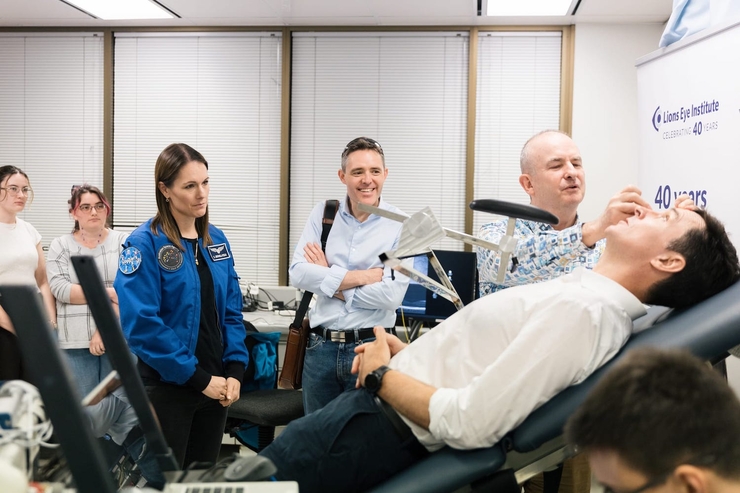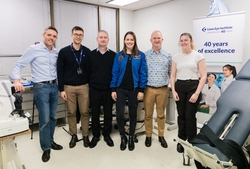Researchers working on a revolutionary new device hope to bring out-of-this-world health solutions for astronauts in space and patients on Earth.
Katherine Bennell-Pegg, the first astronaut to qualify under the Australian flag, recently visited the Lions Eye Institute in Perth to see the groundbreaking technology.
The OcuLinx was designed to monitor intracranial pressure (ICP), which can be an indicator of serious health conditions.
The portable device was developed by a team led by Professors Bill Morgan and Dao-Yi Yu AM, and Dr Anmar Abdul-Rahman.
It measures ICP by analysing large retinal vessel pulse amplitudes, giving accurate readings of the pressure of cerebrospinal fluid surrounding the brain.
"The OcuLinx device represents a groundbreaking advancement in how we monitor intracranial pressure, both for astronauts in space and for patients on Earth," said Prof Morgan, an ophthalmologist and researcher who was Managing Director of the Lions Eye Institute from 2019-2024.
"Its potential to improve outcomes in critical health conditions and space missions is truly exciting," he added.
Ms Bennell-Pegg is now eligible for missions to the International Space Station after graduating from astronaut training in Germany in April 2024.
If she does go into orbit, prolonged exposure to microgravity could lead to space-associated neuro-ocular syndrome (SANS) – which affects over 50 percent of astronauts on missions longer than six months and can result in vision loss.
The OcuLinx reseachers hope the device can become a non-invasive alternative to existing ICP monitoring methods, which involve time-consuming procedures such as lumbar punctures or insertion of internal sensors, and are not suitable for long-term use.
For people living below the stratosphere, the OcuLinx may have promising applications for patients with conditions such as idiopathic intracranial hypertension (IIH), which mainly affects young women and can lead to blindness.
It may also improve outcomes in children with hydrocephalus – a build-up of cerebrospinal fluid that causes pressure in the skull – and provide better differentiation in chronic headache cases.
Designed to help identify treatment issues earlier and support timely interventions with continuous, non-invasive ICP monitoring, OcuLinx is hoped to be commercially available globally by 2027-28.
Read more: Do mobile phones ruin your vision?
Read more: Celebrating 40 years of expanding vision
Next News And Innovation:
1/10/2024 Five-star bonding space for new parents
Previous News And Innovation:
17/9/2024 Robot benefits arrive in north Melbourne
![[APHA]](/images/logo_apha.svg)

